Estimation of Energy Balance throughout the Growing–Finishing Stage of Pigs in an Experimental Pig Barn
Abstract
:1. Introduction
2. Materials and Methods
2.1. Experimental Pig Barn Features
2.2. Experimental Design and Data Collection Process
2.2.1. Growing–Finishing Phase of Pigs
2.2.2. Calculation of Input Energy
Feed Energy
Electrical Energy
Water Pumping Energy
2.2.3. Calculation of Output Energy
Manure Energy
Growth Energy
2.2.4. Calculation of Energy Loss
Physical Activity and Fasting Heat Production Energy
Wastewater and Ventilation Energy
Heating and Light Energy
2.3. Calculation of Energy Balance
2.4. Data Analysis
3. Results and Discussion
3.1. Summary of the Environmental Parameters
3.2. Energy Input concerning Different Growing Phases of Pigs
3.2.1. Measurement of Input Energy from Feed and Water
3.2.2. Measurement of Input Energy from Ventilation Fan, Heater, and Light
3.3. Energy Output concerning Different Growing Phases of Pigs
3.4. Energy Loss by Pigs’ Different Activities According to Different Growing Phases
3.5. Energy Required per kg of Body Weight Gain across Different Growing Phases
3.6. Energy Balance of the Experimental Pig Barn
4. Conclusions
Author Contributions
Funding
Institutional Review Board Statement
Data Availability Statement
Acknowledgments
Conflicts of Interest
References
- Chudy-Laskowska, K.; Pisula, T. An Analysis of the Use of Energy from Conventional Fossil Fuels and Green Renewable Energy in the Context of the European Union’s Planned Energy Transformation. Energies 2022, 15, 7369. [Google Scholar] [CrossRef]
- Igliński, B.; Pietrzak, M.B.; Kiełkowska, U.; Skrzatek, M.; Kumar, G.; Piechota, G. The Assessment of Renewable Energy in Poland on the Background of the World Renewable Energy Sector. Energy 2022, 261, 125319. [Google Scholar] [CrossRef]
- Mkhwanazi, Z. Production of Biocoal from Wastewater Sludge-Biomass Feedstock. Master’s Thesis, Chemical Engineering Faculty of Engineering and the Built Environment Durban U, Durban, South Africa, 2022. [Google Scholar]
- Brockway, P.E.; Owen, A.; Brand-Correa, L.I.; Hardt, L. Estimation of Global Final-Stage Energy-Return-on-Investment for Fossil Fuels with Comparison to Renewable Energy Sources. Nat. Energy 2019, 4, 612–621. [Google Scholar] [CrossRef]
- Rehman, A.; Radulescu, M.; Cismaș, L.M.; Cismaș, C.M.; Chandio, A.A.; Simoni, S. Renewable Energy, Urbanization, Fossil Fuel Consumption, and Economic Growth Dilemma in Romania: Examining the Short- and Long-Term Impact. Energies 2022, 15, 7180. [Google Scholar] [CrossRef]
- Jia, S.P.; Mao, B.H.; Liu, S.; Sun, Q.P. Calculation and Analysis of Transportation Energy Consumption Level in China. Jiaotong Yunshu Xitong Gongcheng Yu Xinxi/J. Transp. Syst. Eng. Inf. Technol. 2010, 10, 22–27. [Google Scholar] [CrossRef]
- Nejat, P.; Jomehzadeh, F.; Taheri, M.M.; Gohari, M.; Muhd, M.Z. A Global Review of Energy Consumption, CO2 Emissions and Policy in the Residential Sector (with an Overview of the Top Ten CO2 Emitting Countries). Renew. Sustain. Energy Rev. 2015, 43, 843–862. [Google Scholar] [CrossRef]
- Frorip, J.; Kokin, E.; Praks, J.; Poikalainen, V.; Ruus, A.; Veermäe, I.; Lepasalu, L.; Schäfer, W.; Mikkola, H.; Ahokas, J. Energy Consumption in Animal Production. Agron. Res. 2012, 10, 39–48. [Google Scholar]
- Paris, B.; Vandorou, F.; Balafoutis, A.T.; Vaiopoulos, K.; Kyriakarakos, G.; Manolakos, D.; Papadakis, G. Energy Use in Greenhouses in the EU: A Review Recommending Energy Efficiency Measures and Renewable Energy Sources Adoption. Appl. Sci. 2022, 12, 5150. [Google Scholar] [CrossRef]
- Benavides, P.T.; Cai, H.; Wang, M.; Bajjalieh, N. Life-Cycle Analysis of Soybean Meal, Distiller-Dried Grains with Solubles, and Synthetic Amino Acid-Based Animal Feeds for Swine and Poultry Production. Anim. Feed Sci. Technol. 2020, 268, 114607. [Google Scholar] [CrossRef]
- Garcia-Launay, F.; van der Werf, H.M.G.; Nguyen, T.T.H.; Le Tutour, L.; Dourmad, J.Y. Evaluation of the Environmental Implications of the Incorporation of Feed-Use Amino Acids in Pig Production Using Life Cycle Assessment. Livest. Sci. 2014, 161, 158–175. [Google Scholar] [CrossRef]
- Kebreab, E.; Liedke, A.; Caro, D.; Deimling, S.; Binder, M.; Finkbeiner, M. Environmental Impact of Using Specialty Feed Ingredients in Swine and Poultry Production: A Life Cycle Assessment. J. Anim. Sci. 2016, 94, 2664–2681. [Google Scholar] [CrossRef] [PubMed]
- Mihina, Š.; Sauter, M.; Palkovičová, Z.; Karandušovská, I.; Brouček, J. Concentration of Harmful Gases in Poultry and Pig Houses. Anim. Sci. Pap. Rep. 2012, 30, 395–406. [Google Scholar]
- Chandra, N.; Jayanta, D.; Basak, K.; Paudel, B.; Eun, N.; Byeong, K.; Moon, E.; Tae, H. Emission of CO2 in a Livestock Barn Based on Diurnal Activities and Various Growing Stages of Pigs. Air Qual. Atmos. Health 2023, 2, 1443–1454. [Google Scholar] [CrossRef]
- Süli, T.; Halas, M.; Benyeda, Z.; Boda, R.; Belák, S.; Martínez-Avilés, M.; Fernández-Carrión, E.; Sánchez-Vizcaíno, J.M. Body Temperature and Motion: Evaluation of an Online Monitoring System in Pigs Challenged with Porcine Reproductive & Respiratory Syndrome Virus. Res. Vet. Sci. 2017, 114, 482–488. [Google Scholar] [CrossRef]
- Cervantes, M.; Antoine, D.; Valle, J.A.; Vásquez, N.; Camacho, R.L.; Bernal, H.; Morales, A. Effect of Feed Intake Level on the Body Temperature of Pigs Exposed to Heat Stress Conditions. J. Therm. Biol. 2018, 76, 1–7. [Google Scholar] [CrossRef] [PubMed]
- Sharpe, K.T.; Reese, M.H.; Buchanan, E.S.; Tallaksen, J.E.; Janni, K.A.; Johnston, L.J. Electrical and thermal energy consumption in midwest commercial swine facilities. Appl. Eng. Agric. 2018, 34, 857–864. [Google Scholar] [CrossRef]
- Kwak, Y.; Shin, H.; Kang, M.; Mun, S.-H.; Jo, S.-K.; Kim, S.-H.; Huh, J.-H. Energy Modeling of Pig Houses: A South Korean Feasibility Study. Energy Strateg. Rev. 2021, 36, 100672. [Google Scholar] [CrossRef]
- Wang, W.; Fan, L.W.; Zhou, P. Evolution of Global Fossil Fuel Trade Dependencies. Energy 2022, 238, 121924. [Google Scholar] [CrossRef]
- Asl, R.; Lammers, P.J.; Honeyman, M.S.; Leaflet, A.S.R. Energy Balance in Pig Production Systems: A Progress Report Energy Balance in Pig Production Systems: A Progress Report. Iowa State Univ. Anim. Ind. Rep. 2008, 654. [Google Scholar] [CrossRef]
- Quiniou, N.; Noblet, J.; van Milgen, J.; Dubois, S. Modelling Heat Production and Energy Balance in Group-Housed Growing Pigs Exposed to Low or High Ambient Temperatures. Br. J. Nutr. 2001, 85, 97–106. [Google Scholar] [CrossRef]
- Baxter, E.M.; Adeleye, O.O.; Jack, M.C.; Farish, M.; Ison, S.H.; Edwards, S.A. Achieving Optimum Performance in a Loose-Housed Farrowing System for Sows: The Effects of Space and Temperature. Appl. Anim. Behav. Sci. 2015, 169, 9–16. [Google Scholar] [CrossRef]
- Kil, D.Y.; Kim, B.G.; Stein, H.H. Feed Energy Evaluation for Growing Pigs. Asian-Australas. J. Anim. Sci. 2013, 26, 1205–1217. [Google Scholar] [CrossRef] [PubMed]
- Rodríguez-Estévez, V.; Sánchez-Rodríguez, M.; García, A.; Gómez-Castro, A.G. Feed Conversion Rate and Estimated Energy Balance of Free Grazing Iberian Pigs. Livest. Sci. 2010, 132, 152–156. [Google Scholar] [CrossRef]
- Lammers, P.J.; Kenealy, M.D.; Kliebenstein, J.B.; Harmon, J.D.; Helmers, M.J.; Honeyman, M.S. Energy Use in Pig Production: An Examination of Current Iowa Systems. J. Anim. Sci. 2012, 90, 1056–1068. [Google Scholar] [CrossRef] [PubMed]
- Moon, B.E.; Kim, H.T.; Kim, J.G.; Ryou, Y.S.; Kim, H.T. A Fundamental Study for Development of Unglazed Transpired Collector Control System in Windowless Pig House. J. Agric. Life Sci. 2016, 50, 175–185. [Google Scholar] [CrossRef]
- Basak, J.K.; Paudel, B.; Shahriar, S.A.; Deb, N.C.; Kang, D.Y.; Tae Kim, H. Prediction of Drinking Water Requirements by Applying Statistical and Machine Learning Models in Growing-Finishing Stage of Pigs. Comput. Electron. Agric. 2023, 210, 107934. [Google Scholar] [CrossRef]
- Lammers, P.J.; Honeyman, M.S.; Harmon, J.D.; Helmers, M.J. Energy and Carbon Inventory of Iowa Swine Production Facilities. Agric. Syst. 2010, 103, 551–561. [Google Scholar] [CrossRef]
- Gaworski, M.; Jabłoński, S.; Pawlaczyk-Graja, I.; Ziewiecki, R.; Rutkowski, P.; Wieczyńska, A.; Gancarz, R.; Łukaszewicz, M. Enhancing Biogas Plant Production Using Pig Manure and Corn Silage by Adding Wheat Straw Processed with Liquid Hot Water and Steam Explosion. Biotechnol. Biofuels 2017, 10, 259. [Google Scholar] [CrossRef] [PubMed]
- Moir, L.; Bentley, L.; Cox, R.D. Comprehensive Energy Balance Measurements in Mice. Curr. Protoc. Mouse Biol. 2016, 6, 211–222. [Google Scholar] [CrossRef]
- Ayoade, D.I.; Kiarie, E.; Neto, T.; Nyachoti, C.M. Net Energy of Diets Containing Wheat-Corn Distillers Dried Grains with Soluble as Determined by Indirect Calorimetry, Comparative Slaughter, and Chemical Composition Methods. J. Anim. Sci. 2012, 90, 4373–4379. [Google Scholar] [CrossRef]
- Kil, D.Y. Digestibility and Energetic Utilization of Lipids by Pigs. Doctoral Dissertation, University of Illinois at Urbana-Champaign, Champaign, IL, USA, 2008; 222p. [Google Scholar]
- Basak, J.K.; Arulmozhi, E.; Moon, B.E.; Bhujel, A.; Kim, H.T. Modelling Methane Emissions from Pig Manure Using Statistical and Machine Learning Methods. Air Qual. Atmos. Health 2022, 15, 575–589. [Google Scholar] [CrossRef]
- Mylostyvyi, R.; Izhboldina, O. Climate Assessment in Modern Sustainable Cattle Barns Using Temperature-Humidity Index; Publishing House “Baltija Publishing”: Riga, Latvia, 2019. [Google Scholar] [CrossRef]
- Misra, S.; Bokkers, E.A.M.; Upton, J.; Quinn, A.J.; O’Driscoll, K. Effect of Environmental Enrichment and Group Size on the Water Use and Waste in Grower-Finisher Pigs. Sci. Rep. 2021, 11, 16380. [Google Scholar] [CrossRef] [PubMed]
- Taylor, C.; Guy, J.; Bacardit, J. Prediction of Growth in Grower-Finisher Pigs Using Recurrent Neural Networks. Biosyst. Eng. 2022, 220, 114–134. [Google Scholar] [CrossRef]
- Chen, H.; Li, S.; Zheng, X.; Liu, C.; Kuzyakov, Y. Annual Greenhouse Gas Emissions from Sheepfolds and Cattle Sheds. Soil Use Manag. 2022, 38, 369–380. [Google Scholar] [CrossRef]
- Labussière, E.; van Milgen, J.; de Lange, C.F.M.; Noblet, J. Maintenance Energy Requirements of Growing Pigs and Calves Are Influenced by Feeding Level. J. Nutr. 2011, 141, 1855–1861. [Google Scholar] [CrossRef] [PubMed]
- Little, S.B.; Browning, G.F.; Woodward, A.P.; Billman-Jacobe, H. Water Consumption and Wastage Behaviour in Pigs: Implications for Antimicrobial Administration and Stewardship. Animal 2022, 16, 100586. [Google Scholar] [CrossRef] [PubMed]
- Wang, L.; Hu, Q.; Wang, L.; Shi, H.; Lai, C.; Zhang, S. Correction: Predicting the Growth Performance of Growing-Finishing Pigs Based on Net Energy and Digestible Lysine Intake Using Multiple Regression and Artificial Neural Networks Models. J. Anim. Sci. Biotechnol. 2022, 13, 10, Erratum in J. Anim. Sci. Biotechnol. 2022, 13, 128. [Google Scholar] [CrossRef] [PubMed]
- Markou, G.; Balafoutis, T.; Mohamed, E.; Papadakis, G.; Michael, P.; Janssen, R. The Cyprus Energy Profile for the Animal Sector: Current Situation and Energy Saving Measures in Combination with RES; European Commission: Brussels, Belgium, 2017. [Google Scholar]
- Li, Q.; Patience, J.F. Factors Involved in the Regulation of Feed and Energy Intake of Pigs. Anim. Feed Sci. Technol. 2017, 233, 22–33. [Google Scholar] [CrossRef]
- Bilardo, M.; Comba, L.; Cornale, P.; Costantino, A.; Fabrizio, E. Relation between Energy Use and Indoor Thermal Environment in Animal Husbandry: A Case Study. E3S Web Conf. 2019, 111, 01042. [Google Scholar] [CrossRef]
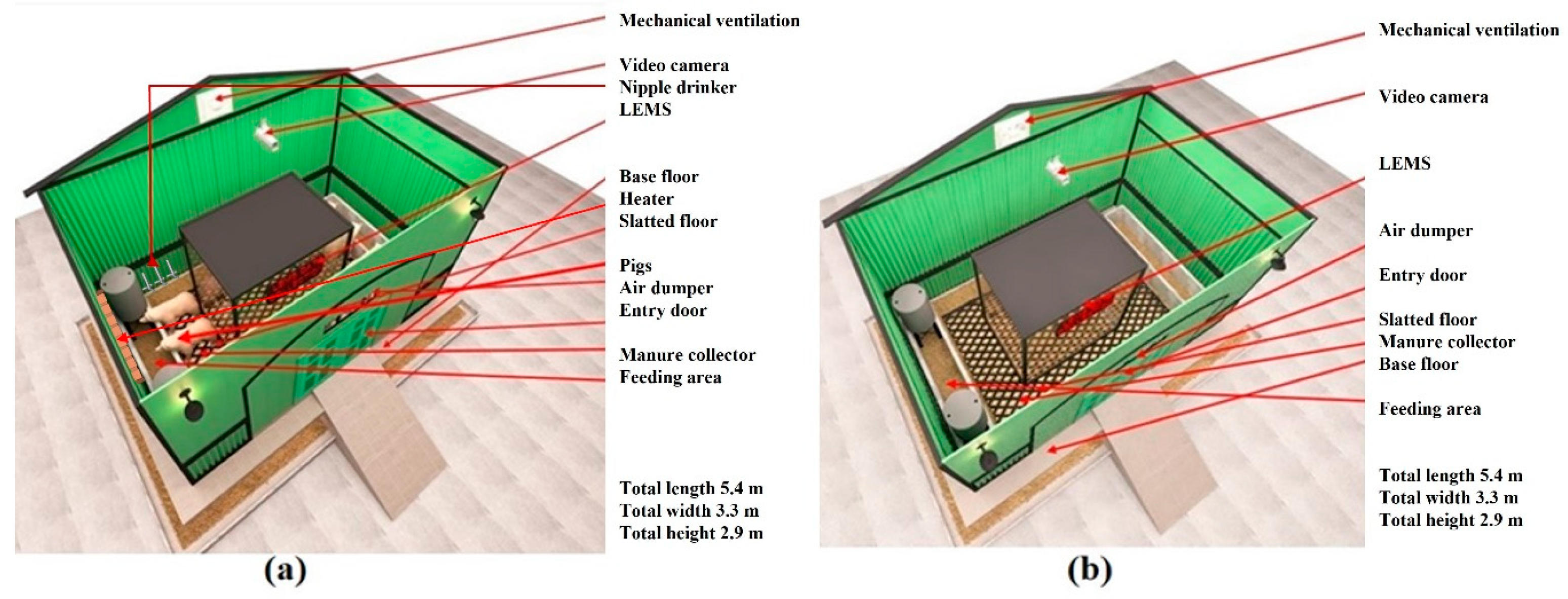
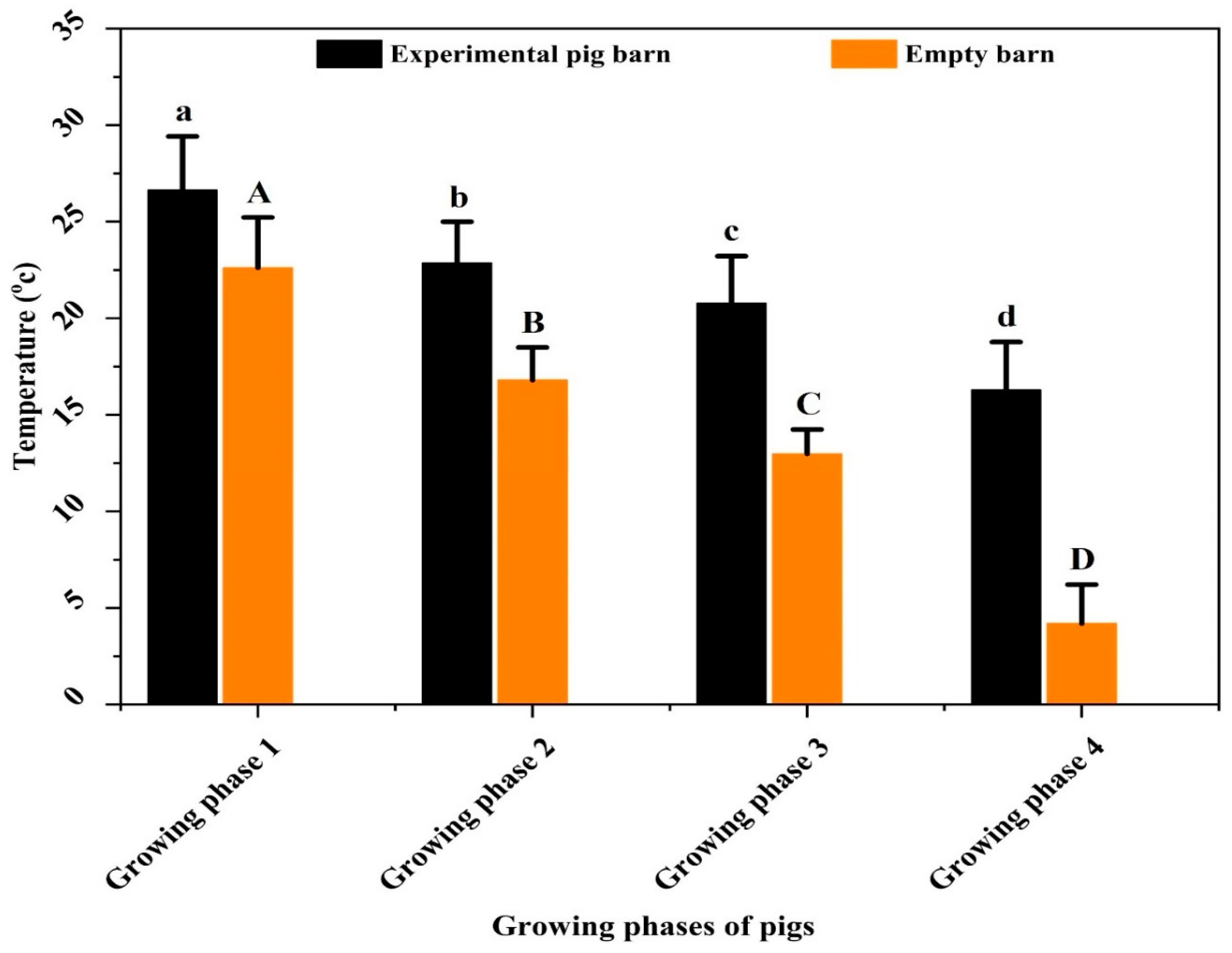

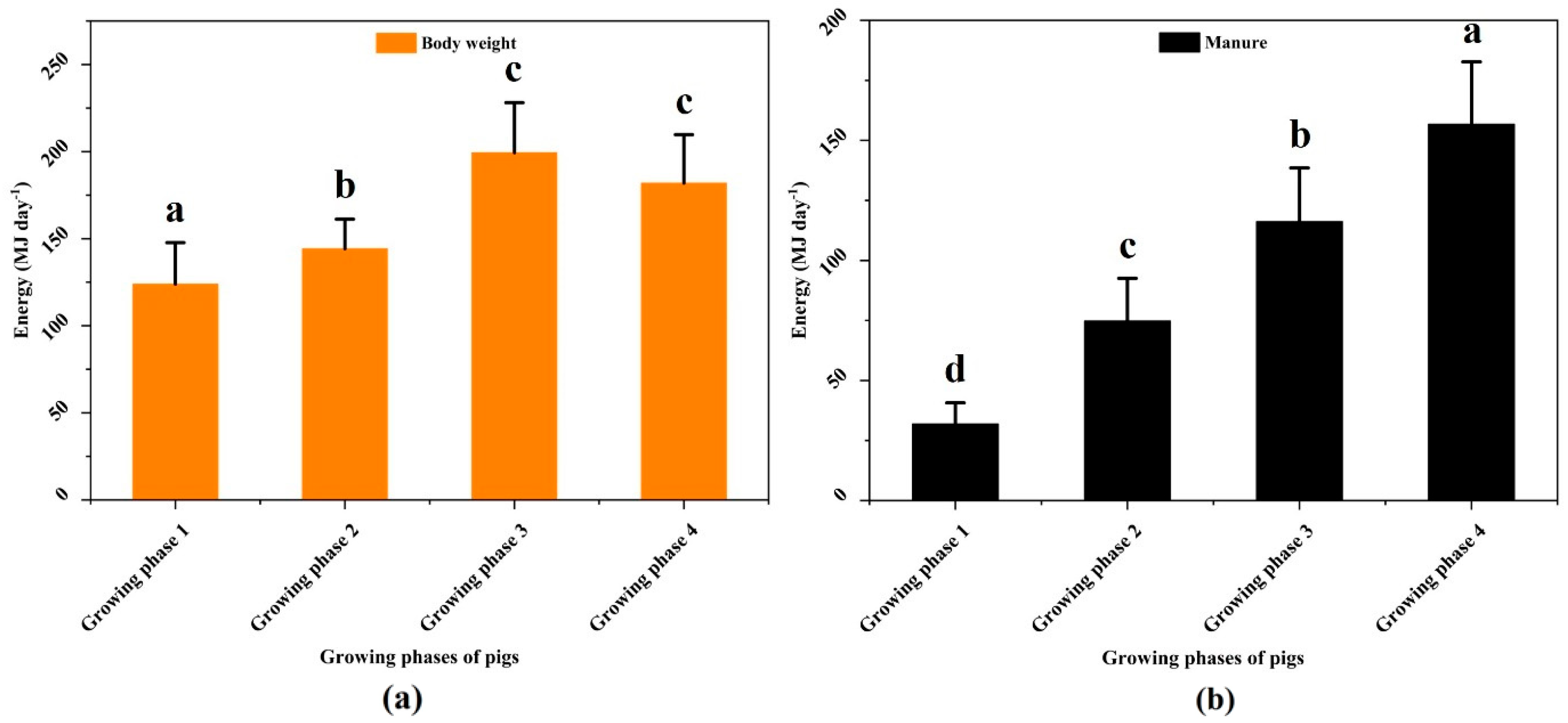
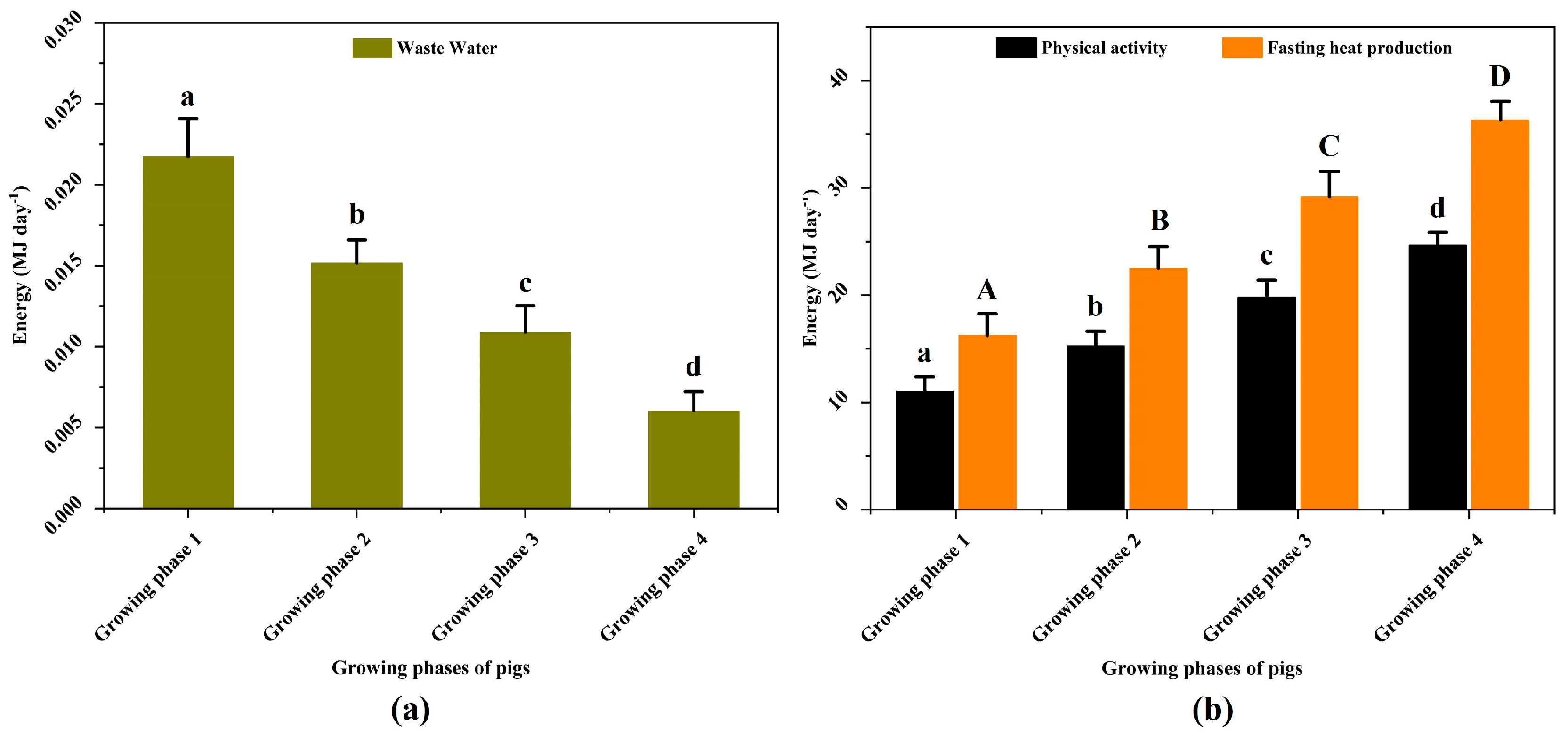
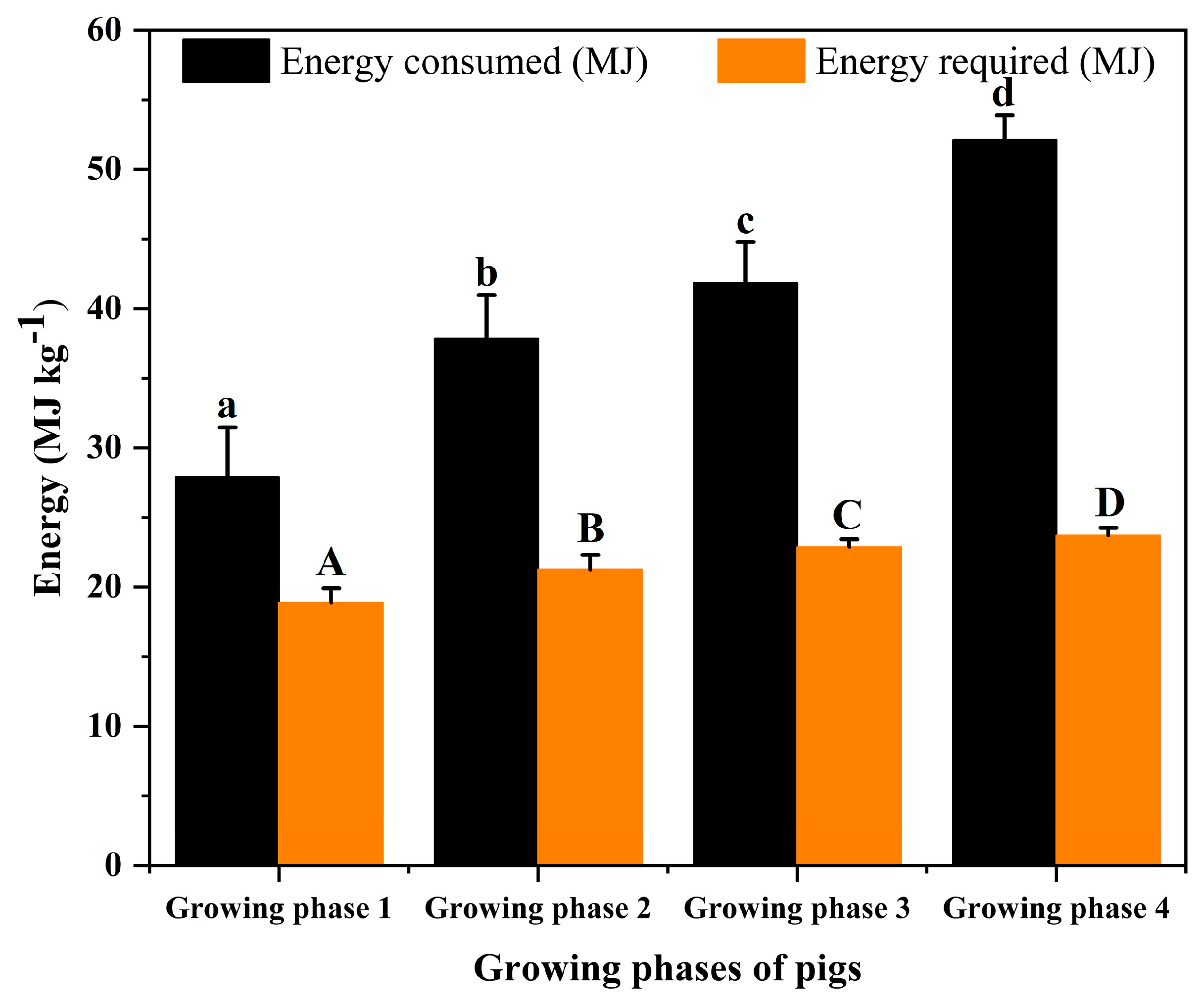
| Ingredients | Nutritional Composition |
|---|---|
| Fat (raw) | >4.5 |
| Ash (raw) | <8 |
| Protein (raw) | <18 |
| Fiber (raw) | <10.0 |
| Calcium | >0.5 |
| Lysine | >0.9 |
| Raw protein (metabolisable) | >12.0 |
| Phosphorus | <1.2 |
| Energy (metabolisable) | 3500 |
| Growing Phases | Items | Energy (MJday−1) | Energy Used during Different Growing Phases (%) |
|---|---|---|---|
| Growing phase 1 | Lights | 14.40 | |
| Electrical heating | − | ||
| Ventilation fan | 30.24 | ||
| Total energy | 44.64 | 15.78 | |
| Growing phase 2 | Lights | 14.40 | |
| Electrical heating | 27.00 | ||
| Ventilation fan | 30.24 | ||
| Total energy | 71.64 | 25.32 | |
| Growing phase 3 | Lights | 14.40 | |
| Electrical heating | 34.20 | ||
| Ventilation fan | 30.24 | ||
| Total energy | 78.84 | 27.86 | |
| Growing phase 4 | Lights | 14.40 | |
| Electrical heating | 43.20 | ||
| Ventilation fan | 30.24 | ||
| Total energy | 87.84 | 31.04 |
| System | Items | Energy Use during Experiment (MJ) | Energy (%) |
|---|---|---|---|
| Input | Feed | 27,691.27 | 80.97 |
| Water | 1.72 | 0.01 | |
| Lights | 1324.80 | 3.87 | |
| Electrical heating | 2401.20 | 7.02 | |
| Ventilation fan | 2782.08 | 8.13 | |
| Total | 34,201.07 | 100.00 | |
| Output | Manure | 8732.57 | 25.53 |
| Energy content in pig’s body | 14,934.18 | 43.67 | |
| Total | 23,666.75 | 69.20 | |
| Loss | Wastewater | 1.24 | 0.01 |
| Physical activity | 1627.75 | 4.76 | |
| Fasting heat production | 2397.26 | 7.01 | |
| Maintenance of barn airflow | 2782.08 | 8.13 | |
| Maintenance of barn temperature | 2401.20 | 7.02 | |
| Illuminate the barn | 1324.80 | 3.87 | |
| Total | 10,534.32 | 30.80 |
Disclaimer/Publisher’s Note: The statements, opinions and data contained in all publications are solely those of the individual author(s) and contributor(s) and not of MDPI and/or the editor(s). MDPI and/or the editor(s) disclaim responsibility for any injury to people or property resulting from any ideas, methods, instructions or products referred to in the content. |
© 2024 by the authors. Licensee MDPI, Basel, Switzerland. This article is an open access article distributed under the terms and conditions of the Creative Commons Attribution (CC BY) license (https://creativecommons.org/licenses/by/4.0/).
Share and Cite
Deb, N.C.; Basak, J.K.; Paudel, B.; Karki, S.; Kang, D.-y.; Jeon, S.-w.; Seo, E.-w.; Kook, J.; Kang, M.-y.; Kim, H.-t. Estimation of Energy Balance throughout the Growing–Finishing Stage of Pigs in an Experimental Pig Barn. Agriculture 2024, 14, 862. https://doi.org/10.3390/agriculture14060862
Deb NC, Basak JK, Paudel B, Karki S, Kang D-y, Jeon S-w, Seo E-w, Kook J, Kang M-y, Kim H-t. Estimation of Energy Balance throughout the Growing–Finishing Stage of Pigs in an Experimental Pig Barn. Agriculture. 2024; 14(6):862. https://doi.org/10.3390/agriculture14060862
Chicago/Turabian StyleDeb, Nibas Chandra, Jayanta Kumar Basak, Bhola Paudel, Sijan Karki, Dae-yeong Kang, Seong-woo Jeon, Eun-wan Seo, Junghoo Kook, Myeong-yong Kang, and Hyeon-tae Kim. 2024. "Estimation of Energy Balance throughout the Growing–Finishing Stage of Pigs in an Experimental Pig Barn" Agriculture 14, no. 6: 862. https://doi.org/10.3390/agriculture14060862









